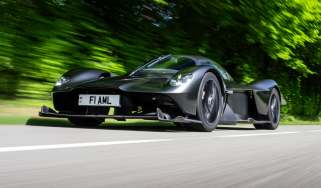Driving the Aston Martin Valkyrie to Le Mans – car pictures of the week
Retracing the tyre tracks of the victorious 1959 Aston Martin racing team, we drive the marque’s odds-defying hypercar from Silverstone to Le Mans.
It’s been said in the past, possibly too frequently given the Aston Martin Valkyrie’s extreme no-compromises design ethos, that it is something of a McLaren F1 moment for the 21st century. A hypercar executed to the ultimate technology standards of its time, willed into existence by a legendary F1 championship-winning designer, with howling V12 power and the cherry on the cake, an after-the-fact repurpose for use in endurance racing.
Not to sound like an Aston Martin press release but there’s no escaping it: this weekend, the Valkyrie’s debut at Le Mans is a big moment in motoring history. It is the first time since the end of the GT1 era that a car with its roots in road use will contest for outright victory at the Le Mans 24 Hours. The last (very loosely) road-linked car to win outright? The Porsche 911 GT1 98, in 1998. The last road-linked car with a V12 to win? Why, that was the McLaren F1 GTR, which famously took everyone by surprise when it dominated the 1995 French enduro.
In celebration of the Valkyrie bringing a road-based car back to the top class at Le Mans, we undertook an ambitious road trip in the road version, from Silverstone to Circuit de la Sarthe, retracing the route taken by the winning Aston Martin racing team of 1959.
It sounds glamorous but very quickly, evo deputy editor James Taylor confirmed for himself some of what’s been reported on the Valkyrie’s pitfalls as a road car. This is a high-downforce concept capable of Le Mans car pace even in road-legal form – and one in which it’s almost impossible to hear your own thoughts, let alone hold a conversation with a passenger, should you elect to forego the military-grade headphones and intercom. But while some of our fears were confirmed, the Valkyrie exhibited some surprising talents as a road car too.
‘I’d expected the Valkyrie to feel a bit of a fish out of water on a road like this, too firm and too low, but it soaks up the most dilapidated of surfaces, and mid-corner lumps and ridges never throw it off course. Yet we’re riding low enough for the aerodynamic channels beneath the car to be engaged. In the video screen ‘mirrors’, I can see a rooster-tail of dust high in the air.
‘There are three driving modes: Urban, Sport and Track. In the last of those, the car sinks even further on its suspension and the dusty rooster-tail gets taller, but it still works on the road. And it’s still so driveable. That’s the thing that really surprises me: despite the car’s apparently limitless abilities, you don’t feel like ballast, like an operator simply turning the wheel and pressing the pedals. It gives you back what you put into it.’ – James Taylor, evo deputy editor, who drove the Aston Martin Valkyrie from Silverstone to Le Mans.
Pleasantly surprising in certain situations the Valkyrie may be but the reality is it’s a very different car to the McLaren F1 with which it’s so often been compared. Its compromises are impossible to ignore but that doesn’t make the fact it exists any less glorious. It’s an object of fascination, a four-wheeled pinup as deserving of adulation as the Pagani Zonda or Lamborghini Countach. As of the 2025 World Endurance Championship season and the Le Mans 24 Hours, it now has true racing pedigree to boot.






